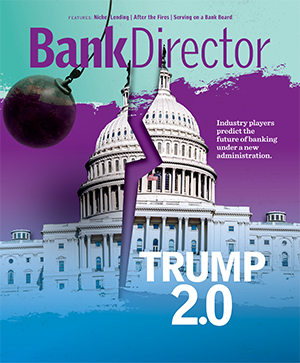Kiah Lau Haslett is the Banking & Fintech Editor for Bank Director. Kiah is responsible for editing web content and works with other members of the editorial team to produce articles featured online and published in the magazine. Her areas of focus include bank accounting policy, operations, strategy, and trends in mergers and acquisitions.

Billions of Sub Debt Set To Reprice, Forcing Banks To Explore Options
Banks that issued billions of subordinated debt back in 2020 and 2021 have important choices to make.
*This article has been updated to correct the spelling of Scott Hildenbrand’s last name.
In January 2020, executives at FB Financial Corp. decided the bank needed more capital.
The Nashville-based bank had just announced its largest acquisition, a $611 million deal to buy nearby peer Franklin Financial Network. Management at the combined entity wanted a larger capital cushion to offset the acquired bank’s construction and commercial real estate concentrations. Not long after, the coronavirus and subsequent lockdowns threatened to derail the U.S. economy.
The now-$13.1 billion FB Financial did what many banks did in 2020 and 2021: It raised capital. Banks raised billions of subordinated debt in the latter half of 2020 and the first half of 2021, as the initial panic of the pandemic subsided and the federal government launched rescue and stimulus plans. Many of these capital issuances had similar characteristics: a bank holding company issued 10-year, fixed-to-floating sub debt that counted as Tier 2 capital and had an initial fixed interest rate for five years. Now, those issuances are nearing their rate reset dates, forcing management teams to revisit these pandemic-era capital decisions in a radically different interest rate environment.
August 2020 was a good time for FB Financial to raise capital. CFO Michael Mettee says management decided to increase the raise to $100 million from the initial $75 million because it was “well oversubscribed,” and the rate came in below what they had modeled. The debt carries a 10-year term with a fixed rate of 4.5% for the first five years. After the reset in September, the rate will change to a floating rate that is the calculated total of 439 basis points plus the current three-month Secured Overnight Financing Rate, or SOFR. If the rate reset at the end of May, for example, it would be 8.73%.
That jump in interest rates is likely to force banks to take a close look at their capital stack and growth prospects. But it’s not the only thing banks with these five-year issuances need to think about, says Kevin Houlihan, a partner at Holland & Knight, whose firm worked on $1 billion-plus of issuances back in 2020-21. He points out that the capital treatment of this debt amortizes, or gradually reduces, for the next five years. In the 10-year issuances, the debt amortizes 20% annually after year five until it’s gone.
This gives banks three choices: Let the interest rate float as the debt amortizes, issue more debt to pay off this debt or call the debt. Each approach has its own costs and benefits, but at current interest rates, none are cheap.
“A bank’s decision is going to depend on a number of factors: where interest rates are, where the reset rate is relative to what the new issuance rate is, a bank’s view of the economy, its funding sources and its strategic growth considerations,” Houlihan says.
With 15.2% total capital, Mettee says FB Financial feels comfortable using some of its excess capital to call the debt. “If you think about the interest expense associated with the capital, it probably doesn’t make sense for us to let it float,” he says.
Other banks that raised capital during this time are still evaluating their options, including Park National Corp. In August 2020, the Newark, Ohio-based bank raised $175 million in a 10-year issuance with a fixed-to-floating rate of 4.5%. CFO Brady Burt says the $9.9 billion bank will decide what to do about two months before the early September call date. The bank already has a total capital ratio of 17%. A new issuance would grow that already large cushion but could be useful to deploy in a deal that would push it above $10 billion in assets.
“We now have far more capital than we really need,” he says. “However, it gives us options when there are acquisitions with interest rate marks and unrealized losses. With excess capital, you don’t need to shy away from those types of acquisitions.”
Investor interest and enthusiasm for issuances in 2025 may be tepid relative to the demand in 2020, warns Scott Hildenbrand, chief balance sheet strategist and head of depository fixed income at Piper Sandler Companies. Five years ago, investors were searching for any investment that would provide yield in the low interest-rate environment, which helped lower the price for sub debt and, in some cases, encouraged banks to increase the size of the offering. Piper Sandler estimates that about $17.5 billion in sub debt is coming due in the second half of 2025 and the first part of 2026 — only now, investors have many attractive yield-offering alternatives.
Institutions facing a substantial rate reset may need a couple of months to explore their options and prepare, say Hildenbrand and Houlihan. This includes calculating the cost of the reset, board-level discussions about the bank’s current capital position, the impact of extinguishing the debt and the potential use and rate of return if the bank opts to issue new capital. Issuing banks may want to get an updated debt rating from a ratings agency and engage with investment bankers and potential investors. These conversations and conclusions will look different at each bank.
Banks that plan to issue new sub debt to redeem the 2020-21 issuances can expect to pay significantly higher rates. A recent $200 million 10-year, fixed-to-floating sub debt offering from Englewood Cliffs, New Jersey-based ConnectOne Bancorp carried a fixed rate of 8.125%. The bank said in its prospectus that it intends to redeem the $75 million of sub debt it issued in June 2020 that carried a fixed rate of 5.75%. On June 2, the bank announced it closed its acquisition of The First of Long Island Corp., which grew its total assets to about $14 billion.
Whatever these institutions choose will provide some indication or hint of what they see for themselves in the future. Some may issue more capital because they want to do a deal or to bolster reserves ahead of an economic downturn. Some may let the debt float and pay the higher rate while it amortizes because they don’t want to spend that much cash to call it. Some may call it because they don’t see attractive risk-adjusted returns. It will depend on the bank’s specific financial condition, the current economic and rate environment and what the bank sees for its future.
“Each decision is a message: Get new capital, wait or call it,” says Piper Sandler’s Hildenbrand. “I would pay attention to each bank’s decision.”



